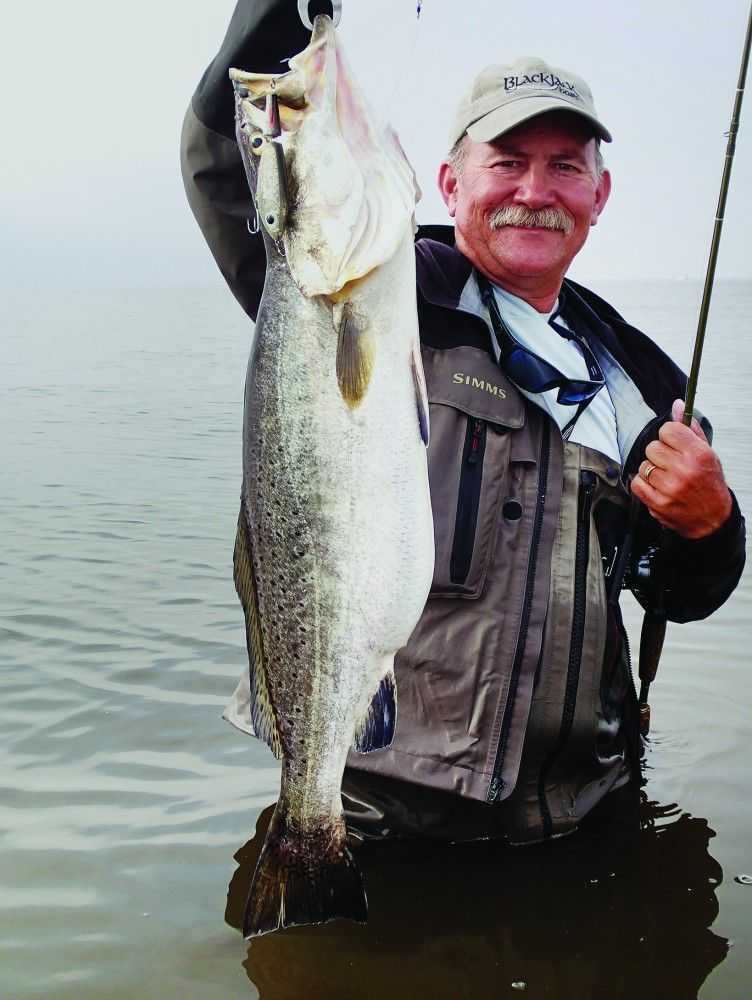
It’s time! …Or at least it should be by now. We saw higher than normal November temperatures, and I’m ready for forage to leave the bay to turn on the big winter trout bite.
Check your gear and select your tackle. Replace worn hooks on your big topwater and slow-sink baits, and put your big-trout confidence baits in your box. Do a little preventative maintenance to your favorite Lew’s reel, and make sure your cold-weather gear is handy.
The baits you want for big trout are large. Big speckled trout won’t spend a lot of time and energy feeding; they want to eat a big mullet, menhaden, pin or piggy perch and be done with it. With the water temps still high, there is always a good chance at surface strikes. We all know that a Super Spook and the One Knocker Spook give plenty of profile for that. I have both, and I’ll throw the One Knocker a lot, especially if I’m still seeing smaller mullet in the 5-inch range. Match the hatch.
Big slow-sinking twitch baits just beg to be eaten. They present themselves very naturally in the water column and are buoyant enough to trick an old wary trout. The top of the line I’ve seen so far is the Broken Back from Steve’s Lures. I talked with Capt. Bruce Baugh who has been field-testing Steve’s Lures in Big Lake, Louisiana. He said the Broken Back, “gives that big profile that the bigger fish are looking for, and it presents like a big injured or slowly dying baitfish”… something big trout can’t resist.
Bruce said he’s been walking them subsurface just like a big topwater. After seven or eight walking twitches, he’ll give the bait a slow steady pull, moving the rod tip from saying the 9:30 to the 10 o’clock position over about a slow six count. It pulls the bait forward just enough to keep it from sinking. To the trout, it actually looks like it’s sitting still. It’s that slow. “That’s when the bigger fish have been hitting it,” Bruce said.
I also asked Bruce if he felt the Broken Back could be used in all the places and scenarios we fish for big trout all the way from the shallow flats of the Lower Laguna to the rivers of Virginia, and he said, “If you can stand to let it sink that long, it should prove to be productive in all those situations.”
When the barometric pressure is high and the bite is off, subtly finessed presentations with larger rat-tail soft plastics can trigger a bite while still providing the larger profile a big trout wants. Hoagies’ Eel Diablo, Kelly Wiggler Ball Tail Shad, Mirr-o-lure Provokers and Saltwater Assassins can all be productive. Working plastic baits like this on 1/8-ounce jig heads takes some time to learn. The rod movements have to be precise and controlled to glide the bait just over the bottom or down the drop off to give that more natural presentation that will fool a big trout. While an erratic presentation can certainly work on pre-frontal bites, post-cold-front conditions leave the fish in a lethargic state. Try to “be the bait,” and move the tip of the rod in such a way that the lure would act like a small baitfish gliding through the strike zone. Try to think sick or injured baitfish. It’s struggling; its movements are slow and it has low energy.
Tobin created TroutSupport.com. Tech Support for Speckled Trout and Redfish Anglers looking for the edge over the competition.